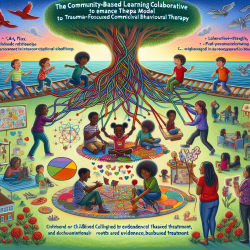Introduction
In the realm of child therapy, the integration of evidence-based treatments (EBTs) is crucial for addressing the mental health needs of children, especially those exposed to trauma. The research article "Testing the Community-Based Learning Collaborative (CBLC) Implementation Model: A Study Protocol" provides valuable insights into how the CBLC model can enhance the implementation and sustainment of EBTs like Trauma-Focused Cognitive Behavioral Therapy (TF-CBT) in community settings. This blog explores the key findings and implications of the study, offering guidance for practitioners aiming to improve their therapeutic practices.
Understanding the CBLC Implementation Model
The CBLC model is an adaptation of the Learning Collaborative (LC) approach, designed to foster interprofessional collaboration (IC) and interorganizational relationships (IOR) across various service sectors, including child welfare, mental health, and juvenile justice. Unlike traditional LC models that focus on single-agency training, the CBLC model emphasizes community-wide engagement to increase the adoption and sustainment of EBTs.
Key Findings from the Study
The study utilized a mixed-methods approach to evaluate the effectiveness of the CBLC model in promoting the penetration and sustainment of TF-CBT. Key findings include:
- Increased Collaboration: The CBLC model significantly enhanced IC and IOR, leading to improved communication and coordination among service providers.
- Improved EBT Adoption: The conjoint training of clinical and broker professionals resulted in higher rates of TF-CBT adoption across participating organizations.
- Sustained Use of EBTs: The model's emphasis on ongoing consultation and support facilitated the long-term use of TF-CBT, even after the formal training period ended.
Implications for Practitioners
Practitioners looking to enhance their therapeutic outcomes can benefit from incorporating the principles of the CBLC model into their practice. Here are some actionable steps:
- Foster Collaboration: Engage with professionals from different service sectors to build a supportive network that can enhance the delivery of EBTs.
- Utilize Conjoint Training: Participate in or organize training sessions that include both clinical and non-clinical professionals to ensure a comprehensive understanding of EBTs.
- Emphasize Ongoing Support: Implement regular consultation calls and meetings to address challenges and reinforce the use of EBTs.
Encouraging Further Research
While the CBLC model shows promise, further research is needed to explore its applicability in diverse settings and with different populations. Practitioners are encouraged to contribute to this body of knowledge by documenting their experiences and outcomes when implementing the CBLC model.
Conclusion
The CBLC implementation model offers a robust framework for enhancing the delivery and sustainment of evidence-based treatments in child therapy. By fostering interprofessional collaboration and interorganizational relationships, practitioners can improve therapeutic outcomes for children, particularly those exposed to trauma. For those interested in delving deeper into the research, the original study can be accessed here: Testing the Community-Based Learning Collaborative (CBLC) implementation model: a study protocol.










